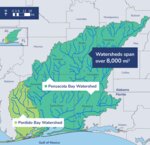PERDIDO BAY — Oysters in Perdido and Pensacola bays are in critical condition. Seagrass is returning, so are manatees. But bacterial concentrations continue to rise. None of this is new …
This item is available in full to subscribers.
Please log in to continue |




PERDIDO BAY — Oysters in Perdido and Pensacola bays are in critical condition. Seagrass is returning, so are manatees. But bacterial concentrations continue to rise.
None of this is new information to those familiar with the two bodies of water that sit near the southeast corner of Baldwin County.
What is new is the effort to cull data about those waters and form a plan that will help improve water quality and life for the creatures that call those places home.
The Pensacola and Perdido Bays Estuary Program released the first State of the Bays report, and it details all that ails or is improving in both bays.
"For folks who are tuned in, none of this is probably a surprise," said Logan McDonald, community outreach coordinator for the estuary program.
The report is presented in an easily digestible online format that maximizes the use of photos, tables and charts to present the information rather than lengthy, jargon-filled paragraphs.
It also takes time to explain terms such as turbidity and what dissolved oxygen is and why it matters.
"That was the goal. We wanted it to be very digestible," McDonald said. "Even if someone does not have a lot of time to dig in, this easily gives them an understanding of what is happening."
It's so easy that a quick scroll through the website tells readers whether a region is critical, improving, stable or undetermined with the use of simple graphics.
The lack of consistent monitoring over the years was the biggest hurdle scientists with the estuary program had to navigate.
Because the bays sit on the border of two states and within several municipalities, they were subject to monitoring by various government entities, many of which didn't measure for the same data or in the same manner.
"In some cases, we were looking at apples and oranges," McDonald said.
That left gaps of information that the estuary program plans to fill in for future reports with consistent monitoring through its own methods.
"We can't give an overall total health of the bays because this is the first version," McDonald said. "It's hard to give an overall good, bad or horrible rating because the pieces are so interconnected."
The estuary program plans to release a state of the bay report every two years.
In January, U.S. Senators Marco Rubio and Rick Scott, both of Florida, introduced Senate Bill 50, which would designate Perdido and Pensacola bays as an estuary of national significance, only the 29th in the nation and the first area so named in nearly 30 years. No action has been taken on the legislation since.
Moving forward, McDonald said efforts by the program and locals who love the water will hopefully push the data toward more positive trends as they put resources and a comprehensive strategy in place to address issues of concern.
More importantly, she said, is reminding those who love to live by the water that they are key to its preservation.
"All the little things we do in our yards make a huge difference," she said. "There are a lot of simple steps people may think don't matter, but it does all add up."